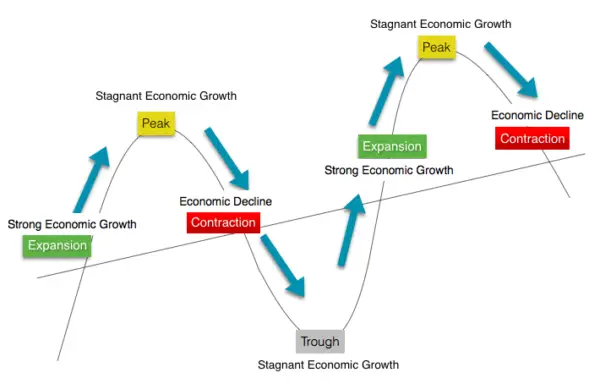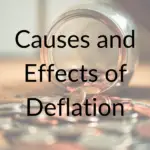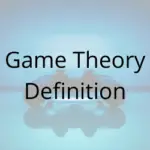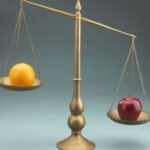Business Cycle: What it is, How it works, Causes & Phases

What is a Business Cycle
The business cycle refers to the transition between economic growth and contraction. This is where a nation experiences a growth in economic activity followed by a decline. In other words, the nation goes from producing more and more goods and services, to producing less and less.
Key Points
- The business cycle is whereby a nations Real GDP goes from growth (expansion) to decline (recession) and back again in a repeating fashion.
- There are 4 main phases of the business cycle – expansion, peak, contraction, and trough.
The business cycle centres around Gross Domestic Product and its relative growth or decline. The cycle has an upward trend, and is made up of periods of economic expansions and recessions. Yet despite the term ‘cycle’, there is nothing periodic about it. Economic expansions could occur for 5 years, 10 years, or 15. There is no set trend to tell how long a business cycle will take.
It is also known as the boom and bust cycle, the economic cycle, or the trade cycle.
Causes of the Business Cycle
Okay, so the business cycle refers to the ups and downs of economic growth. However, what causes this to happen? Can’t the economy just maintain constant growth? Well it is quite a complex matter and is best explained through fluctuations in aggregate demand. Essentially, this is when the population as a whole starts to buy fewer goods and services.
When people buy fewer goods and services, there is less demand. As a result, firms provide fewer goods and services. In turn, they need fewer employees, which may result in redundancies and consequently economic decline.

The decline may never actually happen unless a nationwide fall in demand happens. Some factors that can cause a decline in aggregate demand include: higher interest rates, stricter trade barriers, declining real incomes, reduced government spending, higher taxes, and political uncertainty.
Let’s look at the causes of the business cycle below.
1. Political Uncertainty
Political uncertainty creates fear among the business community which prevents or delays investment. For instance, after the 2016 Brexit vote in the UK, business investment stagnated. When it became uncertain as to how and when the UK would leave the EU, business investment started to decline, particularly into 2018.
There are also more extreme cases such as political and civil unrest. For example, the 2019 Venezuelan Presidential election led to civil unrest following years of hyperinflation and economic mismanagement. This not only reduces the amount of domestic investment but also foreign direct investment. This contributed to Venezuela’s decline back into the business cycle contraction after rapid growth following the 2008 Financial crisis.
2. High Interest Rates
High-interest rates make it more difficult for businesses to invest. For instance, a small store that is just starting is going to find it hard to make repayments at an interest rate of 20 or 30 percent. It also sucks out money from the economy and re-directs it to the banks. As the interest rates are so high, businesses and consumers reduce their demand for credit. In turn, there is a contraction in the money supply which can lead to deflation.
The effects of high interest rates can be dire if not managed correctly and subtly by central banks. If the interest rates are increased too fast, too high, and too rapidly, we will see the aforementioned effects such as lower business investment and deflation. Therefore, it can contribute to a transition towards an economic contraction in the business cycle.
3. Declining Real Incomes
Inflation can create a drain on consumer incomes as it decreases its value year on year. Therefore, if firms do not increase wages in line with inflation, the average worker will be able to afford less than before.
If real incomes decline, it means consumers have less income to spend on goods and services in the economy. In turn, a prolonged period of decline in real incomes can contribute to an economic contraction in the business cycle.
4. Higher Taxes
Higher taxes mean the average consumer has less disposable income, which can contribute to a decline in consumption. Consequently, as consumers demand fewer goods, the overall economy can slide into the contraction phase of the business cycle.
With consumers spending less, there is less demand for goods and services. In turn, the need for businesses to employ as many workers also declines, meaning an increase in employment. We then have a potential downwards spiral by which lower consumer demand leads to unemployment, which leads to a further reduction in demand.
These are only potential effects and depend on how extreme the tax rises are for and who they are placed on. It also depends on how the taxes are spent. For instance, they may be used to re-distribute to the poorer in society. This may offset some of the negative effects as lower-income households tend to spend a higher proportion of their incomes, thereby stimulating consumer demand.
However, they may be used to repay government debt. In which case, there is likely to be a deflationary effect that could create further problems.
5. Reduced Government Spending
As governments reduce spending, it can create a contractionary effect on the business cycle. However, it depends if it is also aligned with a decrease in taxation and whether the savings are spent in reducing debt.
If the government reduces spending to pay off its debt, it can create a trough in the business cycle. This is because the government is still taking the same revenues from the public. There is a negative effect as the government spends less, which is a component of GDP, therefore contributing to a contraction. However, there is a positive effect. If they are paying off debt, this increases the amount of credit available to the rest of the economy. So it may make it easier for businesses to obtain credit to expand their investment
6. High Business Confidence
When business confidence is high, they are more likely to spend and invest. Therefore, we see an expansion in the business cycle.
Business confidence may increase because of growing consumer demand, or a reduction in uncertainty. In turn, businesses are more likely to invest as they anticipate further demand in the future.
7. Productivity Increases
If the productivity of the economy on the whole increases, it means fewer resources are needed to produce the same level of output. This makes it cheaper to produce goods, meaning lower prices can be afforded. In turn, these savings are passed on into the wider economy. Whether this is through lower prices to the consumer or higher profits to businesses.
What this does is create more funds for consumers and businesses to spend elsewhere. In turn, this increases consumer demand and business investment in the long run.
8. Reduced Trade Barriers
As countries start to reduce trade barriers, we see cheaper consumer goods coming in. This acts in a similar way to productivity gains in the fact that goods can become cheaper to the consumer.
As cheaper goods come into the country, consumers have more disposable income to spend on other goods. This means greater demand elsewhere in the economy, which can stimulate employment and push the economy into the expansion phase in the business cycle.
How do Business Cycle’s work
So business cycles occur through increases and decreases in economic output, which are largely a result of fluctuations in aggregate demand. However, how does the cycle work? The whole process works through 4 phases: expansion, peak, contraction, and trough. This is otherwise known as the 4 phases of the business cycle.

As the economy grows, it goes into an expansionary period. This occurs when aggregate demand is growing rapidly. In turn, the economy will reach a period whereby aggregate demand stalls; known as the peak phase. There is little if any economic growth.
Moving to the next stage, there is a contraction whereby fewer goods and services are being demanded. Then, the economy goes into a trough. Aggregate demand may slowly decline, but very slowly. This will occur until the economy picks up back into the expansion phase.
Business Cycle Phases
In the business cycle, there are 4 phases – expansion, peak, contraction, and trough. This cycles through periods of economic growth and back into economic recession.
One of the key questions asked is how long there is between phases. A legitimate question seeing as the graph illustrates a repetitive trend. However, to answer the question; there is no set trend between phases. An expansion may last 2 years or 20 years. It depends on the behaviour of the whole population and how that translates into aggregate demand.
With that said, let us look at the 4 phases now:
Business Cycle Graph

Phase #1 – Business Cycle Boom/Expansion
Otherwise known as a ‘boom’ or economic growth. This phase of the economic cycle occurs when aggregate demand is increasing. In other words, the population as a whole is demanding more goods and services and businesses are providing them.
During this phase, employment and business profits tend to increase. The nation as a whole tends to prosper, confidence is high, businesses invest, and this stimulated further economic growth.Phase #2 – Business Cycle Peak
As economic growth slows, this is what is known as the peak of the cycle. Employment levels remain stable and the economy is reliant on productivity growth to stimulate output. Business investment starts to stagnant as the growth of future demand starts to diminish.
Businesses will still continue to invest, but on a nationwide scale, there is stagnation. What results is a limited economic movement.
Phase #3 – Business Cycle Recession/Contraction
Once aggregate demand starts to fall, we enter into the contraction phase. This is otherwise known as a recession, which we associate with declining employment, business investment, and consumer confidence. Jobs are lost and the overall demand for goods and services is harmed as a result.
Phase #4 – Trough Business Cycle
During this phase, the economy has suffered the worst of the decline. Economic growth remains stagnant, with aggregate demand failing to pick up.
Central banks respond by trying to reduce interest rates or ‘printing’ new money. The aim is to stimulate demand in the economy. For example, if interest rates are lower, it means both businesses and consumers have lower repayment costs; allowing them to spend on other goods.
Business Cycle FAQs
The business cycle is characterised by four unique stages. These are growth, peak, contraction, and a trough. The growth stage refers to economic expansion whereby activity is increasing rapidly. However, as employment and output increases, the economy reaches the peak of its growth. As businesses struggle to find further growth, the economy tends to go into the contraction phase where businesses lay off employees and demand falls. This continues until it reaches the trough stage where the economic decline stops, but the economy is not yet growing again. The whole of this cycle typically lasts around 10 years.
The business cycle is important because it affects everyone. During the growth phase, there are lots of opportunities for new businesses. This is typically because employment is on the rise and consumers tend to have more disposable incomes. However, during the contraction phase, consumers tend to save more as job security decreases – meaning lower demand and opportunity for new business.
The main factors affecting the business cycle are trade barriers, taxation, business and consumer confidence, interest rates, and government spending.
About Paul
Paul Boyce is an economics editor with over 10 years experience in the industry. Currently working as a consultant within the financial services sector, Paul is the CEO and chief editor of BoyceWire. He has written publications for FEE, the Mises Institute, and many others.

Further Reading
 Deflation: Definition, Causes & Effects - Deflation can be caused from a number of factors. However, it should be noted that these factors alone may not…
Deflation: Definition, Causes & Effects - Deflation can be caused from a number of factors. However, it should be noted that these factors alone may not…  Game Theory: Definition & Examples - Game theory is the study of strategic decision making between individuals.
Game Theory: Definition & Examples - Game theory is the study of strategic decision making between individuals.  Covariance - Covariance is a statistical measure that quantifies the relationship and degree of variation between two variables.
Covariance - Covariance is a statistical measure that quantifies the relationship and degree of variation between two variables. 